Java变量
Posted Wecccccccc
tags:
篇首语:本文由小常识网(cha138.com)小编为大家整理,主要介绍了Java变量相关的知识,希望对你有一定的参考价值。
变量
变量是程序的基本组成单位
变量的介绍
-
概念
变量相当于内存中一个数据存储空间的表示,你可以把变量看做是一个房间的门牌号,通过门牌号我们可以找到房间,而通过变量名可以访问到变量(值)。
01:
class Test
{
public static void main(String[] args)
{
int a = 1;
int b = 3;
b = 89;
System.out.println(a);
System.out.println(b);
}
}
02:
public class Var01
{
public static void main(String[] args)
{
int a;
a = 100;
System.out.println(a);
int b = 800;
System.out.println(b);
}
}
03:
public class Var01
{
public static void main(String [] args)
{
int age = 20;
double score = 88.6;
char gender = '男';
String name = "jack";
System.out.println("人的信息如下:");
System.out.println(age);
System.out.println(score);
System.out.println(gender);
System.out.println(name);
}
}
变量使用注意事项

程序中+号的使用
01:
System.out.println(100+98);//198
System.out.println("100"+98);//10098
System.out.println(100+3+"hello");//103hello
System.out.println("hello"+100+3);//hello1003
数据类型
每一种数据都定义了明确的数据类型,在内存中分配了不同大小的内存空间(字节)。
[外链图片转存失败,源站可能有防盗链机制,建议将图片保存下来直接上传(img-FbrdnBSE-1634562064221)(C:\\Users\\Tom\\AppData\\Roaming\\Typora\\typora-user-images\\image-20210906105130378.png)]
上图说明(背)
Java 的两大数据类型:
-
基本数据类型
数值型[byte,short,int,long,float,double]
char,boolean
-
引用类型
类,接口,数组
整数类型
-
基本介绍
java的整数类型就是用于存放整数值的,比如12,30,3456等等
01:
byte n1 = 10;//一个字节的空间
short n2 = 10;//两个字节的空间

整型的使用细节

01:
public class InterTest {
public static void main(String[] args)
{
//Java的整数常量(具体值)默认为int型,声明long型常量须加‘l’或‘L’
int n1 = 1;//4个字节
//int n2 = 1l;//error 不兼容类型,从long转换到int可能会有损失
long n2 = 1l;
}
}
02:
byte n1 = 3;
short n2 = 3;

浮点类型
-
基本介绍
Java的浮点类型可以表示一个小数,比如123.4,7.8,0.12等等
浮点型的分类
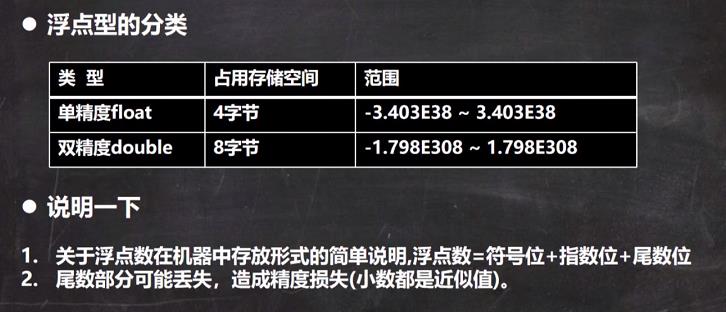
浮点类型使用细节
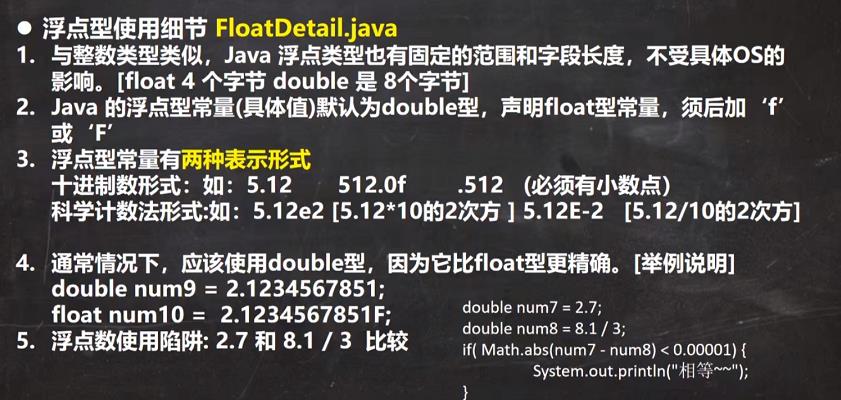
01:
public class FloatTest {
public static void main(String[] args)
{
//Java的浮点型常量(具体值)默认为double型,声明float型常量,须后加‘f’或‘F’
// float num01 = 1.1;//error 默认不写为double double转float会有精度损失
float num01 = 1.1f;
double num02 = 1.1;
double num03 = 1.1f;//correct
//十进制数形式
double num5 = 0.123;
double num6 = .123;//等价0.123
System.out.println(num6);//0.123
//科学计数法形式
System.out.println(5.12e2);//512.0
System.out.println(5.12E-2);//0.0512
}
}
02:
public class FloatTest {
public static void main(String[] args)
{
double num01 = 2.1234567851;
float num02 = 2.1234567851f;
System.out.println(num01);
System.out.println(num02);
}
}
结果如下:

03:
public class FloatTest {
public static void main(String[] args)
{
double num01 = 2.7;
double num02 = 8.1/3;
System.out.println(num01);//2.7
System.out.println(num02);//2.6999999999999997
}
}
得到一个重要的使用点:
当我们对运算结果是小数的进行相等判断时,要小心
public class FloatTest {
public static void main(String[] args)
{
double num01 = 2.7;
double num02 = 8.1/3;
System.out.println(num01);//2.7
System.out.println(num02);//2.6999999999999997
if (num01 ==num02)
{
System.out.println("true");
}
else
{
System.out.println("false");
}
}
}
结果如下:

我们应该以两个数的差值的绝对值,在某个精度范围内判断
public class FloatTest {
public static void main(String[] args)
{
double num01 = 2.7;
double num02 = 8.1/3;
System.out.println(num01);//2.7
System.out.println(num02);//2.6999999999999997
// if (num01 ==num02)
// {
// System.out.println("true");
// }
// else
// {
// System.out.println("false");
// }
if (Math.abs(num01-num02) < 0.000001)
{
System.out.println("true");
}
else
{
System.out.println("false");
}
}
}
结果如下:
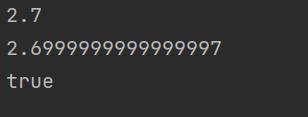
另外,如果是直接查询得到的小数或者直接赋值,是可以判断相等。
字符类型(char)
-
基本介绍
字符类型可以表示单个字符,字符类型是char,char是两个字节(可存放汉字),多个字符我们用字符串String。
01:
public class CharTest {
public static void main(String [] args)
{
char c1 = 'a';
char c2 = '\\t';
char c3 = '唐';
char c4 = 97;
System.out.println(c1);
System.out.println(c2);
System.out.println(c3);
System.out.println(c4);
}
}
结果如下:
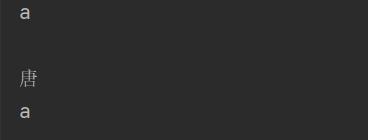
字符类型使用细节
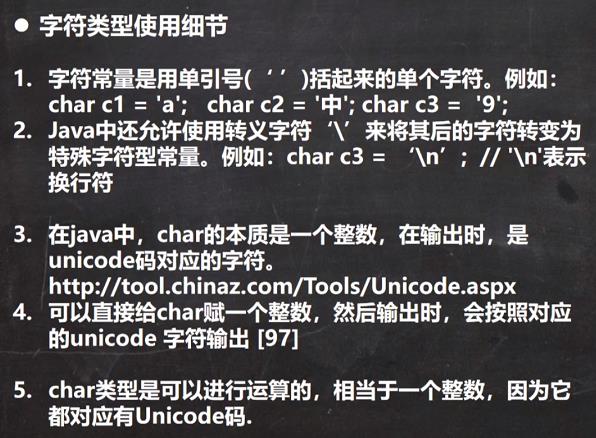
01:
public class CharTest {
public static void main(String [] args)
{
char c1 = 97;
System.out.println(c1);
char c2 = 'a';
System.out.println((int)c2);
char c3 = '唐';
System.out.println((int)c3);
System.out.println(c3);
}
}
结果如下:
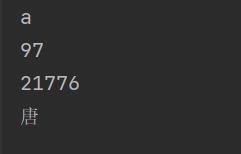
02:
public class CharTest {
public static void main(String [] args)
{
System.out.println('a'+10);//107
}
}
字符类型本质探讨
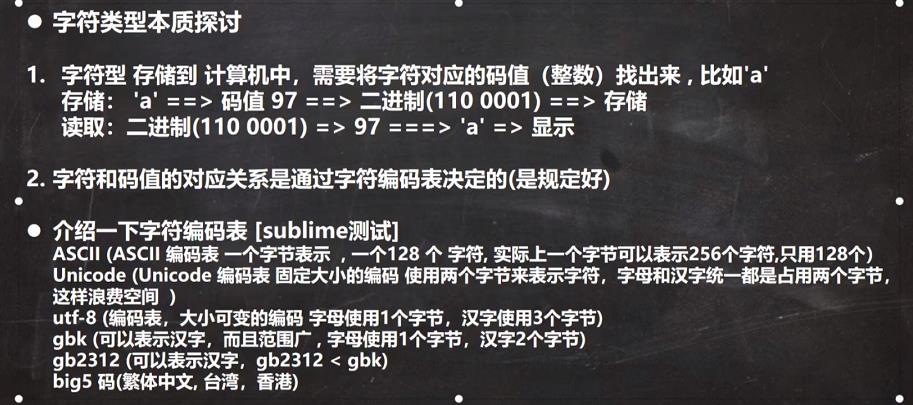



布尔类型:boolean

01:
public class BooleanTest {
public static void main(String[] args)
{
boolean isPass = true;
if (isPass==true)
{
System.out.println("Pass");
}
else
{
System.out.println("No Pass");
}
}
}
使用细节说明
boolean isPass = 0;//error
- 不可以用0或非0的整数替代false和true,这点和c语言不同。
基本数据类型转换

01:
public class ConvertTest {
public static void main(String[] args)
{
int num = 'a';
double d1 = 80;
System.out.println(num);//97
System.out.println(d1);//80.0
}
}
自动类型转换注意和细节
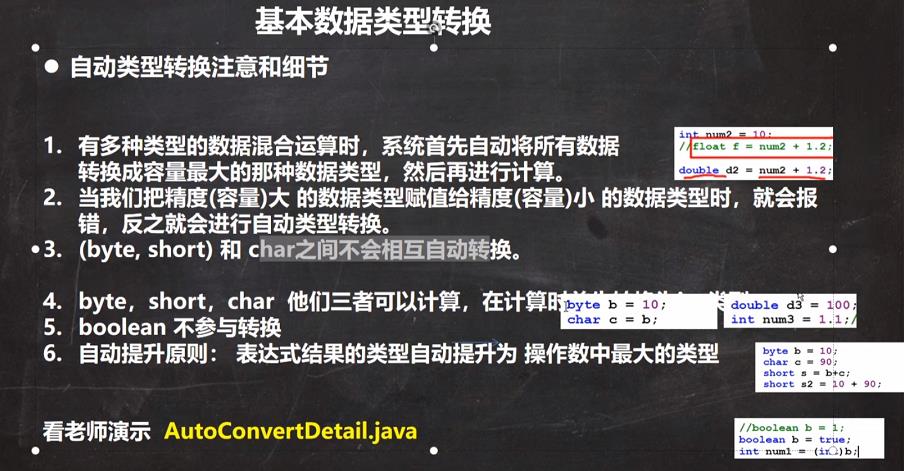
- 有多种类型的数据混合运算时,系统首先自动将所有数据转换成容量最大的那种数据类型,然后再进行计算。
public class ConvertTest {
public static void main(String[] args)
{
int n1 = 10;
//float d1 = n1+1.1; //error double -> float 精度损失
double d1 = n1+1.1;
double d2 =n1+1.1f;
}
}
- 当我们把精度(容量)大的数据类型赋值给精度(容量)小的数据类型时就会报错,反之就会进行自动类型转换。
//int n2 = 1.1;//error double -> int
- (byte,short)和char之间不会相互自动转换
byte b1 = 10;
char c1 = b1;//error 原因:byte 不能自动转成char
- 当把具体数赋值给byte时,先判断该数是否在byte范围内,如果是就可以,如果是变量赋值,判断类型。
byte b0 = 1000;//error 超过范围
byte b1 = 10;//-128 ~ 127
int n2 = 1;//n2 is int
byte b2 = n2;//error int -> byte 精度损失
- byte,short,char它们三者之间可以计算,在计算时首先转换为int类型。
public class ConvertTest {
public static void main(String[] args)
{
byte b2 = 1;
byte b3 = 2;
short s1 = 1;
short s2 = b2+s1;//error b2+s1 => int
int s3 = b2+s1;//correct
byte b4 = b2+b3;//error b2+b3 => int int -> byte 精度损失
}
}
- boolean不参与转换
boolean pass = true;
int num100 = pass;//error boolean不参与类型的自动转换
- 自动提升原则:表达式结果的类型自动提升为操作数中最大的类型。
byte b4 = 1;
short s3 = 100;
int num200 = 1;
double num300 = 1.1;
double num500 = b4 + s3 + num200 +num300;//b4 + s3 + num200 + num300 => double
byte b4 = 1;
short s3 = 100;
int num200 = 1;
float num300 = 1.1f;
int num500 = b4 + s3 + num200 +num300;//error float -> int
double num500 = b4 + s3 + num200 +num300;//correct
强制类型转换
-
自动类型转换的逆过程,将容量大的数据类型转换为容量小的数据类型。使用时要加上强制转换符(),但可能造成精度降低或溢出,格外要注意。
-
案例演示
public class ConvertTest {
public static void main(String[] args)
{
int n1 = (int)1.9;
System.out.println("n1 = "+n1);//n1 = 1 造成精度损失
int n2 = 2000;
byte b1 = (byte)n2;
System.out.println("b1 = "+b1);//b1 = -48 造成数据溢出
}
}
强制类型转换
- 当进行数据的大小从大到小,就需要使用到强制转换
- 强制符号只针对于最近的操作数有效,往往会使用小括号提升优先级
public class ConvertTest {
public static void main(String[] args)
{
//int x = (int)10*3.5+6*1.5;//error double -> int
int x = (int)(10*3.5+6*1.5);//(int)44.0 -> 44
System.out.println(x);//44
}
}
- char类型可以保存int的常量值,但不能保存int的变量值,需要强转
public class ConvertTest {
public static void main(String[] args)
{
char c1 = 100;//ok
int m = 100;//ok
//char c2 = m;//error
char c3 = (char)m;//ok
System.out.println(c3);//d
}
}
- byte和short类型在进行运算时,当做int类型处理
example:
short s = 12;//ok
s = s-9;//error int -> short
byte b = 10;//ok
b = b+11;//error int -> byte
b = (byte)(b+11);//ok
char c = 'a';//ok
int i = 16;//ok
float d = .314f;//ok
double res = c+i+d;//ok float -> double
byte b = 16;//ok
short s = 14;//ok
short t = s+b;//error int -> short
基本数据类型和String类型的转换
- 介绍
在程序开发中,我们经常需要将基本数据类型转成String类型。或者将String类型转换成基本数据类型。
- 基本类型转String类型
01:
public class StringToBasic
{
public static void main(String[] args)
{
//Basic -> String
int n1 = 100;
float f1 = 1.1f;
double d1 = 4.5;
boolean b1 = true;
String s1 = n1+"";
String s2 = f1+"";
String s3 = d1+"";
String s4 = b1+"";
System.out.println(s1+" "+s2+" "+s3+" "+s4+" ");
}
}
- String类型转基本数据类型
语法:通过基本类型的包装类调用parseXX方法即可
01:
public class ConvertTest {
public static void main(String[] args)
{
String s1 = "123";
int以上是关于Java变量的主要内容,如果未能解决你的问题,请参考以下文章